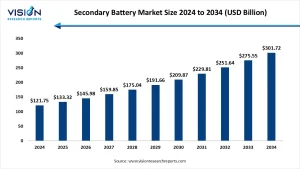The global secondary battery market size was valued at USD 121.75 billion in 2024 and it is predicted to surpass around USD 301.72 billion by 2034 with a CAGR of 9.50% from 2025 to 2034.

Get a Sample@https://www.visionresearchreports.com/report/sample/41652
Secondary Battery Market Overview
Secondary batteries are rechargeable batteries that can be discharged and recharged multiple times. Their ability to store and deliver electrical energy repeatedly makes them vital for applications that demand sustainability and cost efficiency. The market encompasses various types of batteries including lithium-ion, nickel-metal hydride (NiMH), lead-acid, and others, each serving different industrial needs. The rising adoption of electric vehicles, portable electronic devices, and renewable energy integration is the key driver behind the growing secondary battery market. Additionally, governments worldwide are promoting cleaner energy technologies and imposing regulations to reduce carbon emissions, which further propels market growth.
Secondary Battery Market Dynamics
Drivers
- Surge in demand for electric vehicles and energy storage systems
- Technological advancements in battery efficiency and lifespan
- Increasing consumer electronics usage globally
- Government incentives and environmental regulations favoring clean energy
Restraints
- High manufacturing costs of advanced batteries like lithium-ion
- Raw material scarcity and price volatility (e.g., lithium, cobalt)
- Safety concerns regarding battery overheating and fire hazards
Opportunities
- Development of next-generation batteries such as solid-state and lithium-sulfur to enhance safety and energy density
- Expansion of battery recycling infrastructure to recover valuable materials and reduce environmental impact
- Growing adoption of secondary batteries in emerging sectors like grid energy storage and aerospace
- Strategic partnerships and investments in battery technology startups to accelerate innovation and market penetration
Secondary Battery Market Trends
- Lithium-ion batteries dominate: Due to their high energy density and long cycle life, lithium-ion batteries remain the most preferred choice.
- Solid-state batteries R&D: Significant investments in developing solid-state batteries promise safer, longer-lasting, and faster-charging solutions.
- Recycling and sustainability: Growing focus on battery recycling to reduce environmental impact and recover valuable materials.
- Integration with smart grids: Secondary batteries are increasingly used for grid stabilization and peak load management.
Secondary Battery Market Advantages and Disadvantages
Advantages
- Rechargeability reduces long-term costs and waste
- High energy density for compact, lightweight applications
- Versatility across industries (automotive, consumer electronics, energy storage)
- Supports renewable energy adoption by enabling storage
Disadvantages
- Initial cost and raw material dependency can be high
- Limited lifespan compared to non-rechargeable batteries
- Safety risks, including thermal runaway and fire hazards
- Environmental concerns if not properly recycled
Case Study: Tesla’s Impact on Secondary Battery Demand
Tesla’s revolutionary approach to electric vehicles has significantly boosted the secondary battery market. By heavily investing in lithium-ion battery technology and scaling battery production with its Gigafactories, Tesla has lowered battery costs and increased availability. This strategy not only advanced EV adoption globally but also pushed innovation in battery technology, prompting other automakers to follow suit. Tesla’s success exemplifies how strategic investments and technology improvements can catalyze market growth.
Read More:https://www.heathcareinsights.com/microarray-market/
Top Manufactures in Secondary Battery Market
- LG Energy Solution Ltd. (South Korea)
- Contemporary Amperex Technology Co. Ltd. (CATL) (China)
- Panasonic Holdings Corporation (Japan)
- Samsung SDI Co., Ltd. (South Korea)
- BYD Company Ltd. (China)
- SK On Co., Ltd. (South Korea)
- Toshiba Corporation (Japan)
- GS Yuasa Corporation (Japan)
- Envision AESC Group Ltd. (China/Japan)
- Hitachi Chemical Co. Ltd.
Secondary Battery Market Segmentation
Battery Type: Lithium-ion, Lead-acid, Nickel-metal hydride, Nickel-cadmium, Others
Application: Electric Vehicles, Consumer Electronics, Industrial Equipment, Renewable Energy Storage, Others
Region: North America, Europe, Asia-Pacific, Latin America, Middle East & Africa
Among these, lithium-ion batteries in the electric vehicle sector dominate the revenue share, while Asia-Pacific remains the fastest-growing regional market due to robust manufacturing and growing EV adoption.
Future Outlook
The secondary battery market is set for substantial growth driven by accelerating electrification, energy storage needs, and sustainability goals. Innovations in battery chemistry, such as solid-state and lithium-sulfur, promise to improve energy density, charging times, and safety, fueling further adoption. Advancements in battery recycling technologies will address environmental concerns and resource constraints, making the market more sustainable.
Buy this Premium Research Report@ https://www.visionresearchreports.com/report/checkout/41652
You can place an order or ask any questions, please feel free to contact sales@visionresearchreports.com| +1 650-460-3308
